Oil cooler: device and principle of operation,
Every year, with the onset of cold weather, high hopes are placed on central heating, which are not always met. A cool room is not always conducive to working capacity or a relaxing holiday, so you have to stock up on additional sources of heat. An oil heating radiator as the main or additional “stove” will become a source of thermal calories needed for comfort in the house.
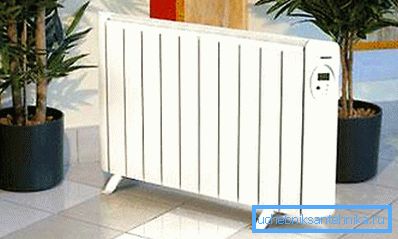
Device and principle of operation
Externally, the product is a hollow steel rectangular accordion case with 5–14 sections, the dimensions of which range from 310x290x667 mm (LxWxH) to 630x290x657 mm. The volume is filled with special mineral oil not up to the top, allowing the coolant to expand when heated. A heating element, a heating element, is mounted in the casing at the bottom side, usually there are 2 of them.
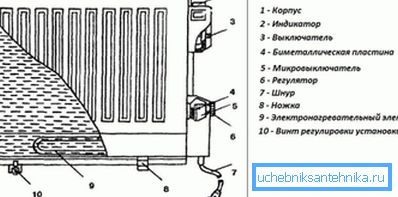
Note! The air inside the sections when interacting with oil does not lead to corrosion and rupture of the body in contrast to water.
On the front side of the device is the control panel, which includes several elements to protect the device from force majeure situations:
- rheostat to maintain a given temperature,
- fuse (disposable or bimetallic reusable wire),
- often there is a sensor for the horizontal position of the device - skewing or tilting the oil radiator is turned off,
- electrical overheating protection
- There are also convenient things like lighting, a compartment for a cord, wheels and a handle for easy movement of the unit (its weight ranges from 5 to 30 kg) in the room.
Note! Additional convenience will bring an oil cooler with a timer, which are of two types. With it, you can set the start / end time or only one of these functions.
The principle of operation of such a radiator is that the heating elements - oil - body - ambient air are consistently heated. Heat is transferred on the principle of convection due to the shape of the casing with vents and fins, and is enhanced by the work of the built-in fan (simpler models can do without the built-in fan).
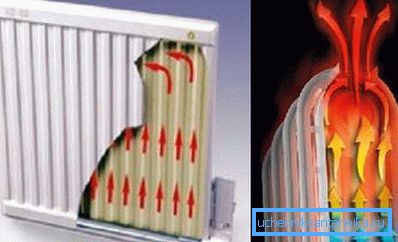
Understanding the details
If we compare the cost of a conventional fan heater and an oil heater, the result will obviously not be in favor of the latter. People who have little understanding of the features of the work of different types of heating devices may be tempted to save, which they will regret bitterly in the future.
The strengths of the oil cooler
Such heaters are just perfect for the role of an additional heat generator in the house.
Convenience of operation provides such a set of advantages:
- reliability, Such devices are used not only for home heating, for example, oil radiators for hydraulic systems are used when it is necessary to maintain a constant temperature of hydraulic oil. The task is responsible with it, they cope perfectly well, so that at home, their effectiveness is quite high;
- economy - thanks to the thermostat, the heater will not work all the time. After the oil temperature in the device reaches the specified value, the heating element will operate in a cyclical mode, periodically activated when the oil cools below the specified threshold;
- no installation required, just install the radiator in the right place. Manufacturers often equip heavy models with wheels and a handle, so that even a child can transport it from room to room with his own hands;

- the surface of the device is not heated, the maximum temperature is usually about 80? C (but this is the maximum), usually it is in the range of 60-70? C. So you can safely leave the radiator even in the nursery;
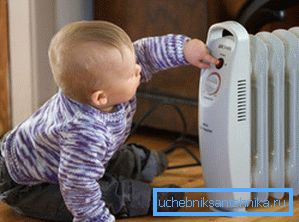
- if the fan is provided by the manufacturer, it rotates at low speed and does not chase dust around the room, as a regular fan heater does;

- manufacturers produce models of oil radiators in a wide range of prices, so you can pick up and budget option, and the model is more expensive;
- quite often, when an oil radiator is chosen, whether oxygen is almost the main criterion. In this regard, you can not worry, the heating elements are not in contact with the air, so that the air is not burned through;
- due to the developed finning oil heaters have a large surface area. This increases heat transfer.
Note! When using fan heaters, the already dry air in winter becomes simply unbearable. So the oil heater and in this indicator in a prize.
There are not so many disadvantages, except that:
- slow rate of warming the room;
- the cost, after all, the price of such devices reaches several thousand rubles, so the purchase does not always look justified.
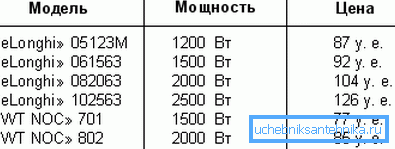
As for how much energy the oil radiator consumes, you cannot simply multiply the maximum power indicated on the package by the number of operating hours. It is necessary to take into account the cyclical nature of the heating element, and this figure depends on many factors (room volume, air temperature, etc.).
Oil radiator characteristics
The documentation usually indicates such characteristics of an oil cooler as:
- power - characterizes the maximum heat transfer of the heater. Available in the range of 0.5-3.0 kW, but high power does not mean that it can completely replace the central heating;
- moisture protection - usually this parameter is not particularly paid attention, but it would be worth it. It is possible to understand whether the heater has such protection by marking, so the IP20 designation means that such protection is completely absent, IP24 provides protection against water splashes, IP21 is an intermediate variant (protection against drops);
- also in modern devices there is a compartment at the bottom for storing the cord, it is very convenient, you do not have to stumble over it constantly when the radiator is turned off;
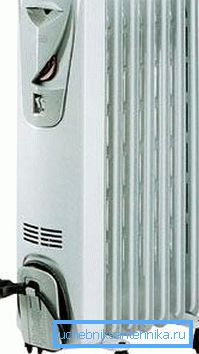
- as for voltage, all oil heaters operate on 220V, so that in this matter they are universal;
- Also in the documentation, the manufacturer usually specifies the dimensions of the heater. Their width and height are comparable with conventional radiators, there is a wide variation in values in depth, there are both thin variants on sale (about 10 cm thick) and more impressive variants (20-30 cm).
Flour of choice
Since when choosing everyone has to solve the same issues, you can list the main nuances that deserve attention.
The selection instructions will be as follows:
- First you need to pay attention to the thermal power of the device, after all, it is selected to heat the housing. On average, 5-7 sections of radiator of standard sizes should be enough for a room of 20-25 m2. In general, one can proceed from the proportion of 100W / 1m2;

Note! If the size of the room is larger, then it is better to get a larger heater. Otherwise there will be an uncomfortable temperature drop.
- it is desirable that it be equipped with a low-current fan, this will accelerate the heating of the room;
- it is undesirable to purchase a model without a thermostat (although it is unlikely that such a rarity will be on sale);
- You can immediately purchase a special nozzle for drying linen heater. In this case, the question of whether to dry clothes on an oil cooler will not be a problem;
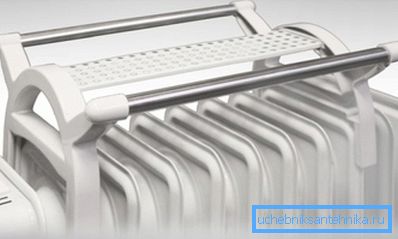
- if the weight of the heater is large, then it must be equipped with wheels, because it will have to be moved from room to room;
- Also a useful addition to the basic configuration will be a container with water (it will maintain the humidity in the room), and an ionizer will make the air beneficial for health altogether.
When an oil radiator is selected - the ranking of the best manufacturers can help. Such heaters are used quite often, so that statistics allows you to select several leaders.
Such manufacturers as DeLonghi, Saturn, AEG, Ergo, Electrolux are quite popular. Each of these companies produces models of heaters in a wide price range, so that the purchase can be chosen for any budget.
In conclusion
Household oil cooler is a great addition to the central heating system. The main thing with the purchase is to understand that this is an addition to the conventional heating system, and not its replacement. It is best to use such heaters in severe frosts, when conventional heating does not cope or during a period when the heating has already been turned off, and the weather is quite cool.
The video in this article describes the subtleties of choosing a suitable oil heater.